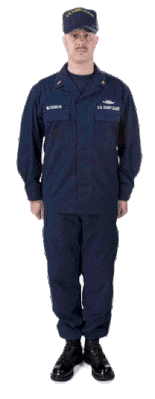Operational Dress Uniform
The Operational Dress Uniform (ODU) is the normal work uniform of the United States Coast Guard, the U.S. Coast Guard Auxiliary, the National Oceanic and Atmospheric Administration Commissioned Officer Corps, and the U.S. Public Health Service Commissioned Corps (PHSCC). It is also one of the uniforms worn by the New York Naval Militia.[1]
 USCG CWO2 wearing ODU (untucked), circa 2010 |
 PHSCC officers wearing ODUs, circa 2014 .png) USCG graduates wearing ODUs, circa 2010 |
History
2000s
The Coast Guard introduced the new "Operational Dress Uniform" (ODU) uniform in 2004 to replace the "Working Blue" and "Undress Blue" uniforms (winter and summer variants). Resembling law enforcement SWAT fatigues, the first generation of ODU differed substantially from the then-current Battle Dress Uniform in that the blouse lacked lower pockets and was intended to be worn tucked into the trousers. The blouse sleeves were allowed to be worn rolled up or down according to personal preference. The trousers featured large cargo packets with buttoned closures and were worn bloused above the boots (or straight legged if worn with boat shoes). A dark blue Coast Guard unit ballcap was worn with this uniform.
A 2006 issue[2] of the Reservist magazine[3] was devoted to a detailed and easy-to-understand graphical description of all the authorized uniforms.
In 2008, a new generation of the ODU was introduced and gradually replaced the tucked version through 2012. This second generation featured an untucked shirt blouse, and was therefore unofficially known as the "Untucked ODU." The blouse featured a Coast Guard insignia embroidered in black on the right breast pocket and the trouser cargo pocket flaps.
In 2008, ODUs were adopted by the National Oceanic and Atmospheric Administration Commissioned Corps, replacing the U.S. Navy working khakis.
From the 1980s until the late 2000s, Coast Guard units engaged in combat operations or otherwise deployed overseas generally wore the U.S. Navy Combat Utility Uniform (the Navy version of the Battle Dress Uniform). When the Navy replaced the CUU with the Navy Working Uniform Type II and Type III, circa 2009, the Coast Guard followed suit.
2010s
In 2015, the ODU uniform was adopted as the daily work uniform of the United States Public Health Service Commissioned Corps, replacing the Battle Dress Uniform.[4]
In August 2016, the United States Navy announced it was eliminating the Navy Working Uniform Type I in favor of the Type III as its standard working uniform ashore. The Type I has earlier been found to not be suitable for shipboard use and the Navy began developing a standard uniform for sea duty. The ODU has been viewed as one potential model.
In September 2017, Coast Guard Uniform Board 47 announced several changes to the ODU. Notably, the Coast Guard insignia would no longer be embroidered on the trouser pocket flaps and that "U.S. COAST GUARD" would no longer be stenciled on the left breast of the T-shirt. Additionally, wear of the boonie hat was more widely permitted.
See also
- Uniforms of the United States Coast Guard
- Uniforms of the United States Coast Guard Auxiliary
Notes
- "New York Naval Militia Instruction 1020.1C" (PDF). New York State Division of Military and Naval Affairs. 26 January 2018. Retrieved 20 May 2018.
- http://www.uscg.mil/reservist/issues/2006/06/issue.pdf
- http://www.uscg.mil/reservist/
- It’s New, It’s Blue, It’s the PHS ODU!, dcp.psc.gov, dated 11 September 2013, last accessed 10 September 2016